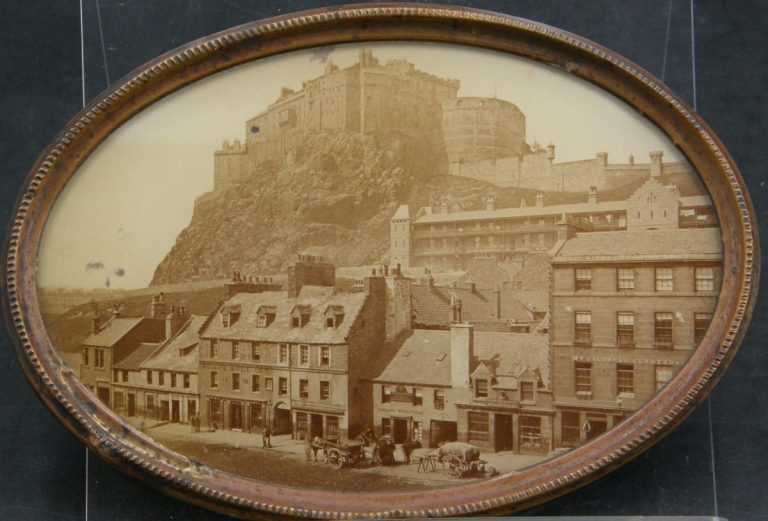2037:: 1850s Albumen Photo Edinburg Castle by G.W. Wilson, oval copper medallion frame

SKU-2037::
George Washington Wilson Company medallion, oval copper frame housing an albumen photograph of Edinburgh Castle in Scotland. View encompasses market on the city street at the time.
Exterior image, oval, horizontal presentation, features a long view of the most famous landmark in Scotland, Edinburgh Castle, as well as the commercial enterprises nearby, housed in its original copper frame under glass with a cardboard back. Verso text reads: “G.W. Wilson & Co. Medallions.”
Commercial signage in photo reads: “Wm. Caldwell Clydesdale, 12 Black Bull Inn 12, 12 Spirit J. Wilkinson Merchant 12, Tobacco & Snuff Manufactory, Carriers Warehouse”.
‘G.W. Wilson & Co.’ was established by George Washington Wilson (1823-1893), of North East Scotland. Early on in his career Wilson found his way to Edinburgh and later to London by the 1840’s where he learned the art of the portrait miniaturist. Like so many of his artistic peers in the 1850’s, he took up the new fad of photography because he had to; there was strong public demand for photographs. In Aberdeen he established himself by plying his old skill, painting, and his new skill, photography. Immediately he was a sensation and quickly won the patronage of the Royal Family when they discovered him on one of their trips to their Balmoral Estates (ca.1854). Shortly later he was appointed Photographer Royal for Scotland in 1860. The Royals would use his expertise for the remainder of his career.
Dimensions: 4⅜”H 6⅜”W.
Fine Condition.
BIOGRAPHY
George Washington Wilson (Scottish: 1823-1893) was to find fame when he became one of Scotland’s Premier Photographers. He was born in 1823 at Waulkmill of Carnousie in Banffshire and left school at 12 years of age to be an Apprentice Carpenter. He practiced his Artistic skills by drawing Portraits of friends & neighbours and, after training at Art Schools in Edinburgh and London, he returned to Aberdeen to become an Art Teacher & Portrait Painter. By the late 1840s Wilson was attracted by the work of Fox Talbot in the new Art of Photography and after initial experiments with a personal homemade Camera, he advertised a Business offering Photographic Portraits before eventually expanding into Landscape Photography.
1823 – Born in Alvah, Banffshire. – Appointed a Joiner in his native Parish. Did a good deal of Portrait painting.
Studied at the Academy Schools in Edinburgh. Studied at the Royal Academy School in London. Received lessons from the Miniature Portrait Painter, Mr Corbould.
1849 – Returned to Aberdeen, intending to take up Portrait Painting. Constructed several remarkably good camera lenses, with which he carried out a series of very interesting experiments.
In September 1850 an Advertisement appeared in the local papers of Aberdeen for “Hays’ Isometrical View of Aberdeen, giving a Distinct & Correct View of the Whole City and Environs”. The Plan was available to purchase for 3/6d and measured 34in by 19ins. Carvers & Gilders, J & J Hays, had premises at 2 Market Street where they also sold Prints & Optical Instruments. At the bottom left of the image are the words George Wilson, Delt. (an abbreviation of Delineator, i.e. the 27-year-old Artist). He was to find fame a few years later as George Washington Wilson when he became one of Scotland’s premier Photographers. G W Wilson created this Panoramic ‘birds-eye’ view of the City by making numerous sketches from the roofs of high buildings and then merging them into one large comprehensive Drawing, he captured the City actually as it was at this time – open fields are visible just to the North of the West end of Union Street. A key to the most Prominent Buildings was provided and it is interesting to see which buildings have survived until today, often with additions, and those which had yet to be built. Robert Gordon’s Hospital (now College), Marischal College, and various Churches including the Triple Kirks & St Nicholas (East & West) are all still standing but the West Prison, Castlehill Barracks and the Poorhouse have been demolished. In December 1889, the Aberdeen Free Press offered its readers an updated version of the Bird’s Eye View as a supplement to their Newspaper. Numerous changes to the Landscape of the City had taken place since Wilson’s Artistic Record.
1852 – Entered into partnership as a Miniature Portrait Painter with Mr Hay (Hay and Lyall).
(RE: https://doriccolumns.wordpress.com/famous-dons/g-w-wilson/)
Scotland 1850s c.Reference number: 2021.2037
Click here to print.
go back
